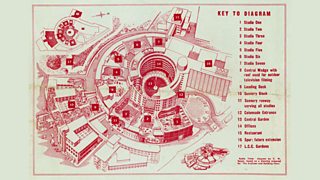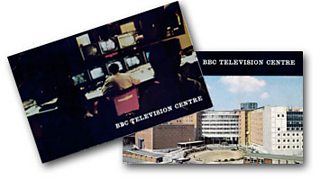Television Centre in the ΒιΆΉΤΌΕΔβs own words
Matt Verrill
Technical Project Manager, Childrenβs Interactive
Tagged with:
My nameβs Matt Verrill, Iβm a Technical Project Manager in ΒιΆΉΤΌΕΔ Childrenβs Interactive and Iβm an avid collector of ΒιΆΉΤΌΕΔ memorabilia. Iβve a reasonably large collection now, ranging from the Corporation's annual Handbooks which formally summarised the previous yearβs accounts and activities, badges, stamps and all sorts of other odds and ends which otherwise might have ended up in a bin somewhere.
The doors to ΒιΆΉΤΌΕΔ Television Centre, in its current guise, will close for the final time at the end of this month, bringing to an end 59 years of service to television viewers around the world. in style in a couple of weeks and there are already a whole host of articles and interviews on the . To accompany all of that, I wanted to trawl back through my collection of Beeb memorabilia and fill in some of the buildingβs story from the Corporationβs own publications.
Television Centre gets its first significant mention in the 1951 ΒιΆΉΤΌΕΔ Handbook, although not by name - it would remain the 'Radio Centre containing Television Headquarters' for some time. Marmaduke Tudsbery, the ΒιΆΉΤΌΕΔβs civil engineer, tells the story of how a permanent site for television production had been discussed since the start of the TV service in 1936 and, when television started up again after the Second World War, it was clear that Broadcasting House wasnβt large enough to contain all of the Corporationβs London-based activities.
In 1949, the ΒιΆΉΤΌΕΔ successfully appealed to the London County Council to develop 13 acres of an empty site at White City (previously earmarked by the Council for housing). Mr Tudsbery recalls having visited the site for the opening of the 1908 Franco-British Exhibition (where it was also used as a venue for the Summer Olympics of that year) and notes that the site was, at that time, the largest undeveloped area in London that it would have been possible for the ΒιΆΉΤΌΕΔ to acquire.
Although it officially opened for business in June 1960, the 1961 Handbook relates how the 'Scenery Block' was completed in 1953 and occupied the following year to service the Lime Grove studios down the road in Shepherds Bush. The 'Restaurant Block' was finished in 1955 and used first as offices and rehearsal space, before being converted for its primary purpose, ready for opening night on 29th June 1960.
The first transmission from TV Centre, a one-off variety special called First Night, came from studio TC3. The souvenir programme issued to the studio audience that night contains a diagram of the building and its layout, much of which remains the same to this day:

To commemorate the opening of TV Centre the ΒιΆΉΤΌΕΔ published a coffee table book giving viewers a look behind the gates at Wood Lane. Some of the pages are shown below, and thereβs a focus on both the scale and the aesthetics of the building. The modernist style might not have been to everyoneβs taste (and bits of it, like any building that makes liberal use of concrete for decoration, havenβt dated well), but there was nothing of todayβs generic chrome-and-glass office buildings about 'TVC'.

In amongst arty shots of the new building in all its shiny, just-unpacked glory, there are some choice nuggets of numerical information to give readers an idea of the scale of operation at the newly-opened Centre:
βΜύΜύΜύΜύ The building is designed to produce 1500 hours of programmes per year
βΜύΜύΜύΜύ 4 of the 7 planned studios are to be initially completed and equipped
βΜύΜύΜύΜύ 3 echo chambers are built into the basement, for providing reverberation effects
βΜύΜύΜύΜύ There are 2 escalators and 43 lifts (passenger and service) across the site
βΜύΜύΜύΜύ 1 television set is completed in the scenery workshops every 30 minutes of every working day
βΜύΜύΜύΜύ Over 500,000 sq. ft. of timber is used every year
βΜύΜύΜύΜύ There are 36 single dressing rooms, with a further 85 which can cater for a total of 613 performers
βΜύΜύΜύΜύ The kitchens can serve 750 people in a single sitting, and serve 3 sittings in sequence
βΜύΜύΜύΜύ The internal telephone exchange serves 2000 extensions, with capacity for 1000 more
With the exception of studio audiences, the general public werenβt yet allowed within the confines of TVC (bookable studio tours wouldnβt be available for many years). To satisfy the continued interest in what was now a world-famous landmark, the Corporation published promotional booklets to give some insight into the amount of work that went on on the other side of the fence:

The 1970 Handbook reports on the move of News broadcasting from Alexandra Palace to the newly-built Spur (the βstemβ of TVCβs question mark-based design). This move to state-of-the-art facilities allowed Television News to finally switch all of its output to full-colour, (the abandoned facilities at Ally Pally were immediately filled by the new Open University service). The Spur was completed in 1997 with the opening of the ΒιΆΉΤΌΕΔ News Centre, finally bringing Television Centre out and onto the pavement of Wood Lane.
Through the 1980s, Television Centre had become a star in its own right, whether in the opening montages of live spectaculars like Comic Relief and Children In Need, or as a supporting player in memorable sequences from Fry & Laurie, Kenny Everett and a host of other comedy big-hitters.
For those of us lucky enough to have worked there, visited as an audience member, or just seen it in the background of a programme, itβs going to be the end of an era. Itβs comforting to know that the familiar structure of the ββ is going to be preserved, and the Beeb wonβt be leaving forever. But it will be a sad day for some of us when we turn on our televisions, knowing that never again will a programme begin with the words βLive from ΒιΆΉΤΌΕΔ Television Centre in London ...β
Μύ
Matt Verrill is Technical Project Manager, ΒιΆΉΤΌΕΔ Children's Interactive.
Watch a selection of clips from broadcast on the ΒιΆΉΤΌΕΔ Four website.Μύ
will be broadcast on Friday 22 March at 8.30pm on ΒιΆΉΤΌΕΔ Four.
The was announced on 20 July 2012. Plans for the future development of Television Centre including the return of ΒιΆΉΤΌΕΔ Studios & Post Production and ΒιΆΉΤΌΕΔ Worldwide can be found .Μύ
